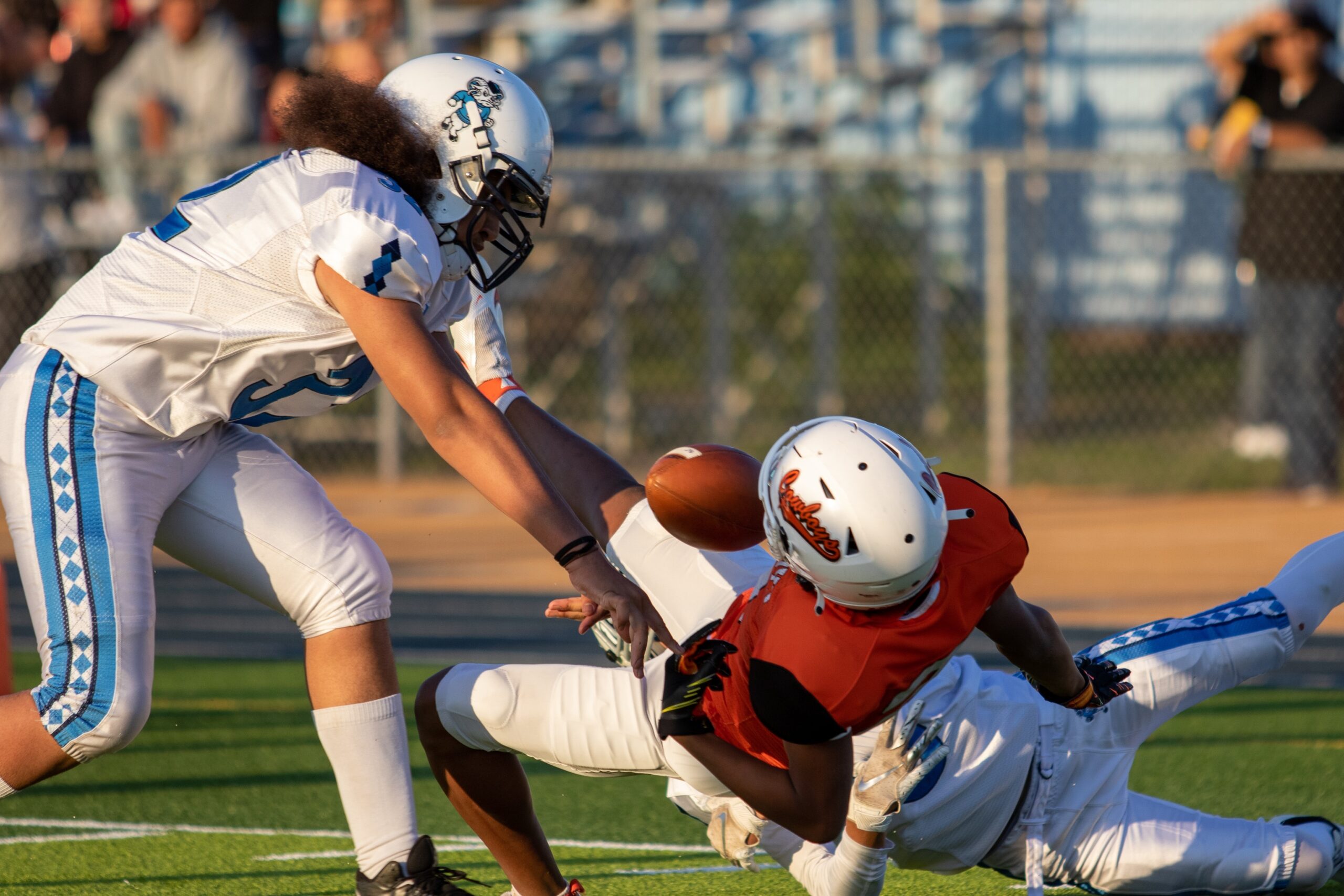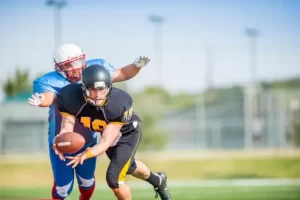In the highly competitive game of football, takeaways are crucial moments that can quickly alter the course of a game. There are different terms for different plays, such as a takeaway. What is a takeaway in football? A takeaway refers to a play where a turnover results in the possession of the football switching between teams. This change in possession may occur due to defensive actions such as interceptions or fumbles. By examining the vital role takeaways play in football, we can better appreciate their importance to a game’s outcome. Basically a takeaway is getting the ball off a turnover.
Interceptions and fumbles are the two main types of takeaways in football. Interceptions occur when a defender positions themselves in the path of a pass and successfully catches the ball, taking it away from the intended receiver. On the other hand, fumbles arise when a player loses control of the ball, and the opposition manages to recover possession. Both types of takeaways signify a shift in momentum and provide an opportunity for the defense to transform into the offense, potentially leading to a score.
Coaches and players are always striving to create a takeaway culture within their football programs. By emphasizing the importance of takeaways during practice, teams can improve their chances of forcing turnovers during games. Drills such as scoop and scores, strip/punch maneuvers, and tip drills are often incorporated into practice sessions to help develop these essential skills. By understanding and practicing the art of the takeaway, football teams can work towards securing victories on the field.
Contents
Understanding Takeaways
Turnovers
Takeaways in football occur when a team’s defense switches possession of the ball with the opposing team’s offense due to turnovers. Turnovers include two main types: interceptions and fumble recoveries. These plays are a momentous part of the game as they allow the defense to “take” the ball away from the offense, often changing the course of the contest.
Interceptions
Interceptions are a type of takeaway that occurs when a defensive player successfully catches a pass intended for an offensive player. The interception gives possession of the ball to the team that performed the interception. Some factors that can lead to interceptions include:
- Poorly thrown passes
- Miscommunication between the quarterback and receiver
- Exceptional defensive play, such as a defender reading the quarterback’s eyes or anticipating the receiver’s route
Fumble Recoveries
Fumble recoveries are another type of takeaway in football, happening when an offensive player loses possession of the ball, and a defensive player recovers it. This can occur during a run, a sack, or even after a completed pass. Some factors that can lead to fumbles and their subsequent recoveries include:
- Ball-carrier losing grip on the ball due to contact with defenders
- Defenders actively attempting to strip the ball from the ball-carrier
- Poor execution of a handoff or snap between the quarterback and another player
In conclusion, takeaways are crucial plays in football involving the change of possession from one team to another through interceptions or fumble recoveries. They can significantly impact a game’s outcome and are a testament to a solid defensive effort.
Importance of Takeaways
Momentum Shifts
Takeaways in football can significantly impact the momentum of a game. When a defense is able to force a turnover through an interception or fumble, it not only prevents the opposing offense from scoring but also energizes their own team. This sudden change in possession can boost morale, confidence, and overall performance for the team that benefits from the turnover.
Field Position
Another important aspect of takeaways is the effect on field position. When a defense forces a turnover, the ensuing possession often occurs closer to the opposing team’s end zone, giving their offense a better opportunity to score. This advantageous field position can make it easier for the offense to score points and increase the likelihood of securing a victory in the game.
Generally Win Games
Statistically, winning the turnover battle is often correlated with winning football games. For example, in the NFL, teams that won the turnover battle won 78 percent of their games during one season 1. This demonstrates the importance of emphasizing takeaways in a football program, as creating a culture that promotes forcing turnovers can significantly contribute to the overall success of a team.
Takeaway Strategies
Forcing Fumbles
One of the most effective ways to create a takeaway in football is by forcing a fumble. To do this, defenders are trained to tackle aggressively with the intent of dislodging the ball from an opponent’s possession. Some techniques employed by teams include:
- Strip/punch: Defenders attempt to knock the ball out of a ball carrier’s grasp by punching it or pulling it away, often focusing on the exposed “points” of the football.
- Pop the elbow: While wrapping up an opponent in a tackle, the defender targets the ball carrier’s elbow, causing it to bend and potentially force a fumble.
- Gang tackling: Ensuring multiple defenders swarm to the ball to increase the chances of a fumble by overwhelming the ball carrier and increasing pressure.
What a play by Logan Wilson to force the fumble 👏 @ljw21
📺: #BALvsCIN on NBC
📱: Stream on NFL+ https://t.co/hNJJJGqxGF pic.twitter.com/YYeDOrkjzO— NFL (@NFL) January 16, 2023
Reading Opposing Quarterbacks
Intercepting the opposing team’s passes is another key takeaway strategy. The ability of a defensive back to read the opposing quarterback and anticipate the intended receiver can significantly increase the likelihood of an interception. Some tactics to employ include:
- Watching the quarterback’s eyes: Observing the quarterback’s gaze to determine which receiver they may target and reacting accordingly.
- Understanding offensive tendencies: Defenders must study the opposing team’s offensive schemes to anticipate play calls and positioning. Familiarizing oneself with an opponent’s favored routes, play calls, and receiver preferences can prove crucial in creating takeaways.
- Maintaining proper positioning: Defensive backs need to position themselves correctly in relation to the receiver to obstruct passing lanes and increase the chances of an interception. This involves understanding how to leverage their body and use angles in relation to the targeted receiver.
Tom Brady’s first redzone interception since 2019 😬 pic.twitter.com/uhMggRPWLz
— PFF (@PFF) January 17, 2023
Incorporating these techniques and strategies into a team’s defensive practice can help foster a strong takeaway culture, ultimately leading to more turnovers and increased chances of team success.
Takeaway Statistics
Individual Records
In football, individual takeaway records are typically measured by a player’s total interceptions and fumbles recovered during their career. Here are some notable records:
- Most career interceptions: Paul Krause, 81
- Most interceptions in a season: Dick “Night Train” Lane, 14
- Most career fumbles recovered: Jim Marshall, 29
- Most fumbles recovered in a season: Don Hultz, 10
Team Records
Team takeaway records are generally focused on the total number of takeaways a team accumulates in a single season. Some notable team records include:
- Most takeaways in a season: 1984 Seattle Seahawks, 63
- Fewest takeaways in a season: 2019 Cincinnati Bengals, 16
- Most takeaways in a single game: New Orleans Saints and San Francisco 49ers, both with 10
League Trends
Analyzing league-wide trends for takeaways provides insights into how the game has evolved over the years. Some noteworthy trends are:
- Since the 1970 merger, average interceptions per game have decreased from 1.85 to 0.94 (1970-2021)
- Conversely, average fumbles forced per game have increased from 1.50 to 2.03 (1970-2021)
- Teams with a positive turnover differential (more takeaways than giveaways) have consistently displayed an increased likelihood of making the playoffs, as well as having more success during the postseason
By examining individual records, team records, and league trends for takeaways, it is evident that these plays can have a significant impact on the outcome of a game and the overall success of a team.
Conclusion
Takeaways in football occur when a turnover results in the possession of the ball switching between teams. These events contribute significantly to the outcome of games, as they alter the momentum and flow of play. Two main types of takeaways exist: interceptions and fumbles.
Interceptions happen when a defensive player catches a pass intended for an offensive player. To be successful in this action, the defender must have both feet inside the field of play when catching the ball.
Fumbles on the other hand occur when an offensive player loses possession of the ball, and the defense recovers it. Players can intentionally create fumbles by performing strip/punch and pop the elbow techniques.
In both cases, the defensive team’s ultimate goal is to take the ball from the offense and change possession to their advantage.



